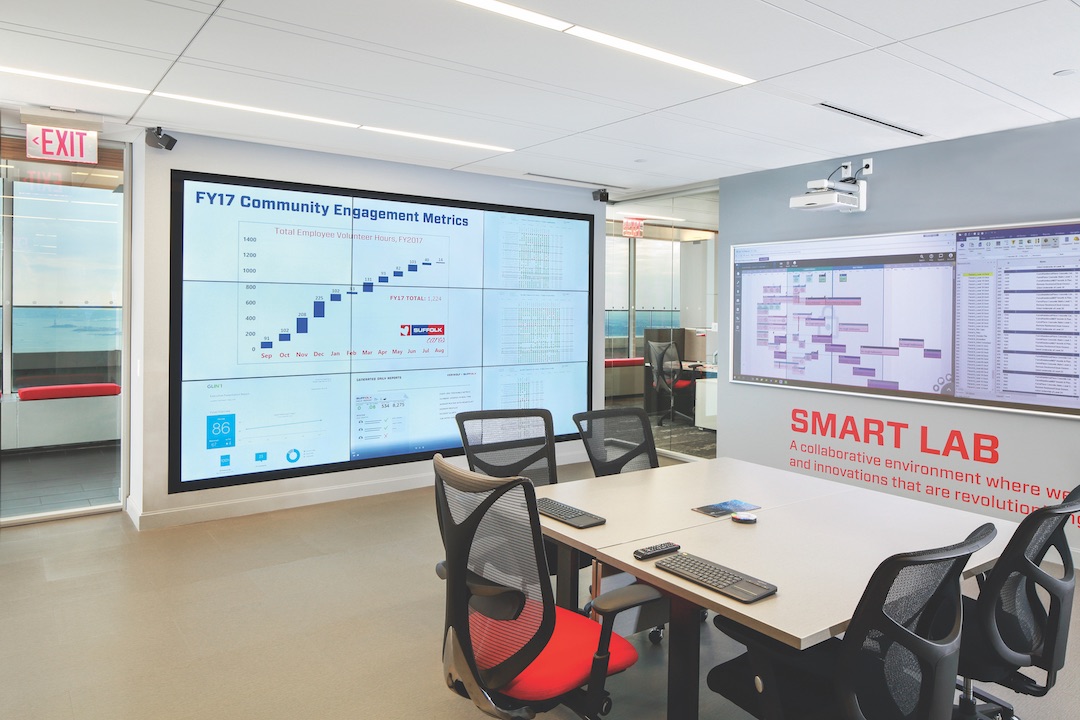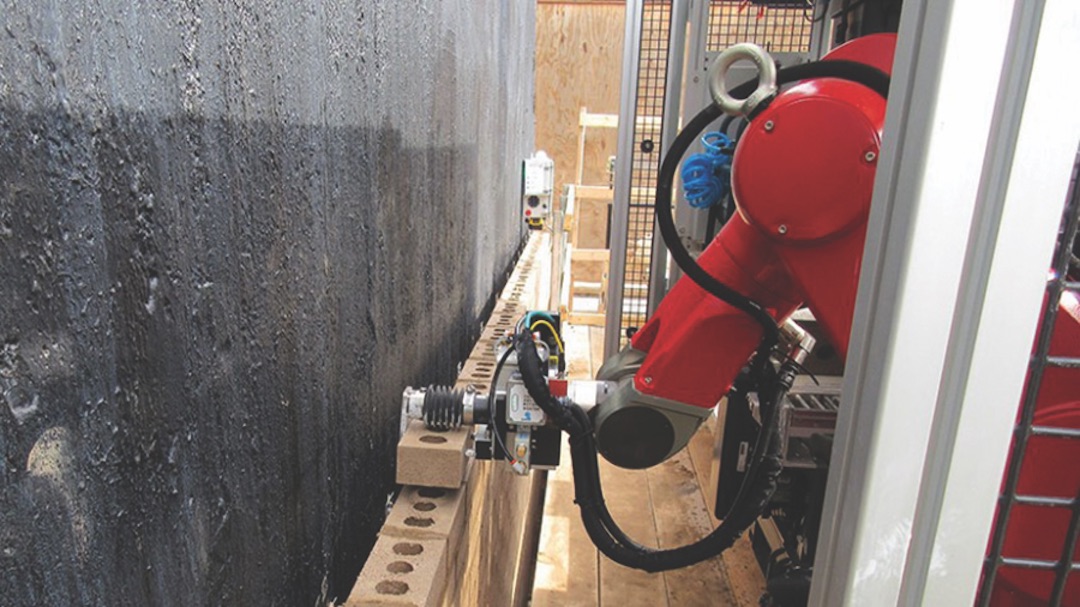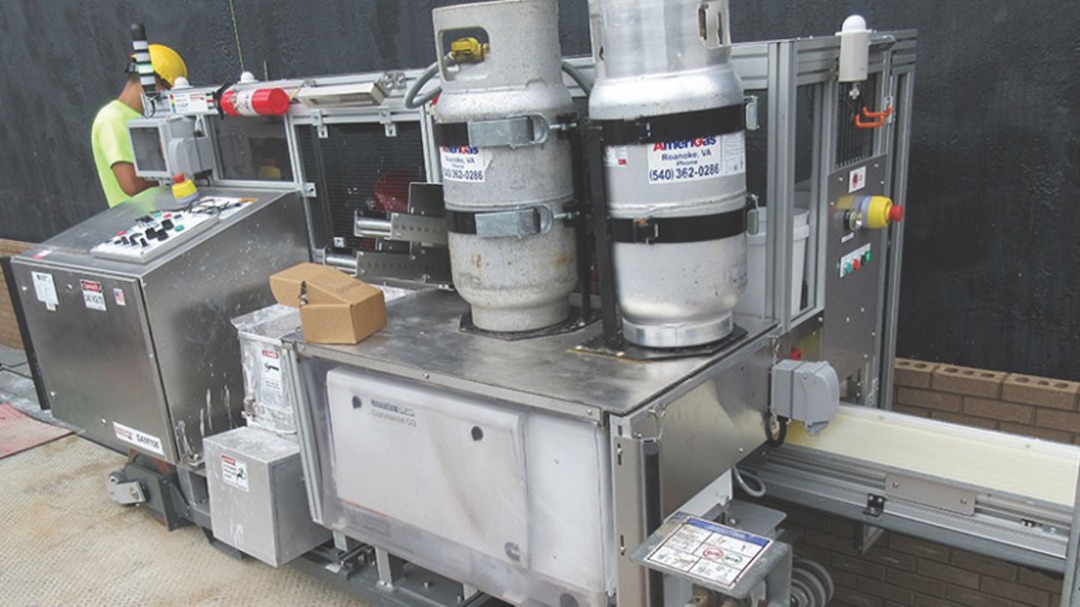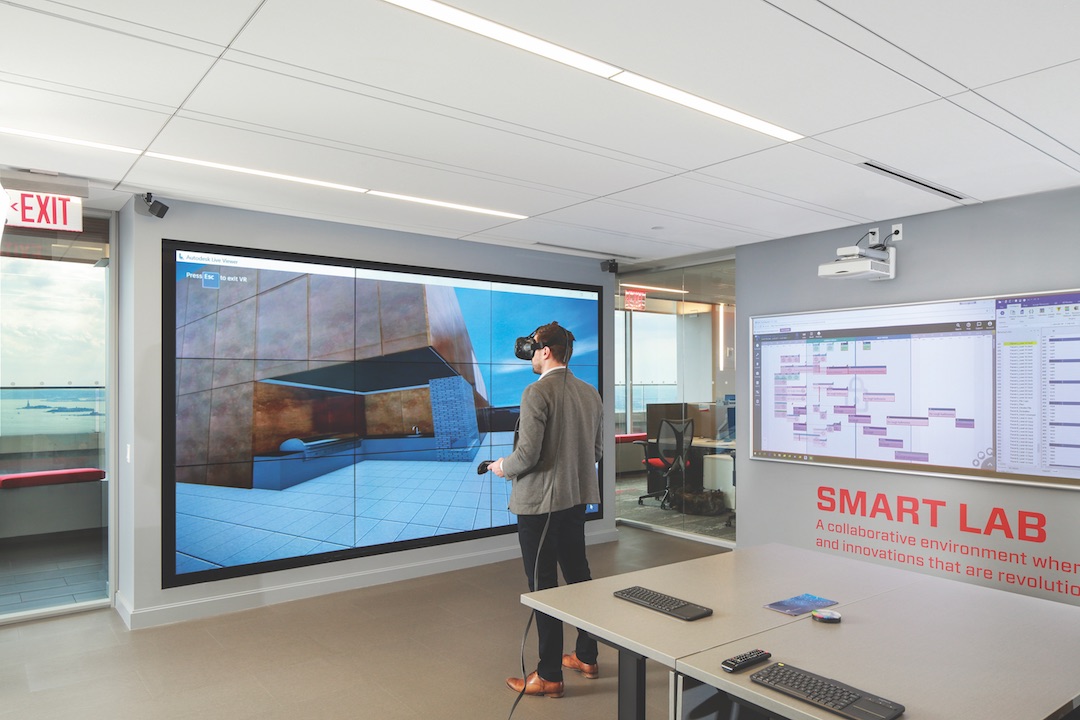As BIM/VDC adoption rates have accelerated substantially over the last decade, helping to usher the design and construction industry into the digital age, a slew of heralded technologies—from VR to computational design—has emerged to reveal that the AEC world is ripe for a seismic disruption.
At the center of this tech infusion is the smart jobsites movement. BD+C caught up with three construction giants—Suffolk Construction, Robins & Morton, and Hoar Construction—to learn about their latest smart jobsite strategies. Here’s what they had to share:
SUFFOLK’S SMART LABS
Taking inspiration from the science and technology industries, Suffolk Construction has created dedicated spaces, called Smart Labs, to capture and study data, collaborate across project teams, and test new technologies and processes. The firm’s first such space came on line in June 2017, in its San Francisco office, followed by New York and Boston late last year. Labs are opening in Miami and Tampa, Fla., this month, with Los Angeles in the queue.
The Smart Labs function as “operational control towers” that allow Suffolk executives to monitor their projects nationwide in real-time, giving them progress updates and financial data. Each lab has massive video screens across a data wall, with live camera feeds from all 90 of Suffolk’s current jobsites. The labs are also equipped with a CAVE virtual reality area, where team members, clients, and prospects can review projects in immersive 3D environments.
The intent of this first-of-its-kind initiative in AEC is to serve as an ecosystem to harness data to proactively stave off construction problems and to better anticipate scheduling and materials needs. The labs help Suffolk executives make best use of organizational talent and minimize waste and inefficiency by removing the high levels of unpredictability that accompany fluid construction environments.
 Suffolk’s Smart Labs function as “operational control towers” that allow the firm’s executives to monitor their projects nationwide in real-time, giving them progress updates and financial data. Suffolk Construction.
Suffolk’s Smart Labs function as “operational control towers” that allow the firm’s executives to monitor their projects nationwide in real-time, giving them progress updates and financial data. Suffolk Construction.
“Information in context is much more powerful than information that is plugged in one data point at a time,” says Chris Mayer, Suffolk’s Chief Innovation Officer. “We take this collection of information and have data-enabled meetings across project teams, where we can then fine-tune our forecasting, staffing, planning, and control process to be as close to our customers needs as possible.”
Mayer says the firm’s long-term plans involve writing custom code and developing algorithms that will help better pinpoint service delivery.
ROBINS & MORTON’S SLATPLANNER
Frustrated by the limitations of analog production planning systems, Steve Moore, PMP, PSP, LEED AP, Division Scheduling Manager with Robins & Morton, realized that there was an opportunity to invent a hybrid system. Developed over nine months, he set out to create an offering that allows for the hands-on elements of scheduling (i.e., arranging sticky notes on a wallboard), which encourage collaboration, with a digitized method for collecting and analyzing important project-related data.
SlatPlanner, currently in beta testing, is Moore’s brainchild that enables the scanning of all information arranged on a wallboard and then allows users to see a history of activity that shows the percentage of planned vs. completed work, lists failure reasons, tracks manpower allocation, and automates overall plan feasibility to help eliminate some of the scheduling gaps and guess work.
The subscription-based offering is expected to launch this June, at the AEC NEXT Technology Expo and Conference in Anaheim, Calif.
 By mid-2018, the company expects to have six Smart Labs operational at its offices across the country, including in Boston, Los Angeles, Miami, and New York. One of the featured software is from TouchPlan, seen on the right side of the image above. Suffolk Construction.
By mid-2018, the company expects to have six Smart Labs operational at its offices across the country, including in Boston, Los Angeles, Miami, and New York. One of the featured software is from TouchPlan, seen on the right side of the image above. Suffolk Construction.
To be more Lean-focused, Robins & Morton recently implemented delivery scheduling software from Voyage Control. The firm’s Logistics Superintendent, Rusty Bratcher, explains that the impetus for adopting the software came out of a logistically complex project for the Medical University of South Carolina, in Charleston.
“The campus is tightly situated in downtown Charleston and is subjected to heavy amounts of pedestrian and automobile traffic, along with ambulances needing to get in and out quickly at all hours of the day,” says Bratcher. “There were big concerns about being efficient across numerous delivery points on site, but for also creating problematic congestion in a cramped environment that includes a busy parking garage.”
To keep from impacting downtown traffic patterns, the Robins & Morton team scheduled all deliveries during the second shift, and none earlier than 5:30 p.m. Having previously used a basic spreadsheet for scheduling deliveries, the firm felt it needed something more sophisticated to maximize efficiencies.
Bratcher says the cloud-based software has eliminated the bottlenecks of crowded gate arrivals with a backlog of trucks waiting to unload their supplies. The firm is able to pinpoint delivery times and coordinate trucks in single-file formation, while knocking out wasted downtime for drivers in the process. Bratcher can book deliveries months in advance, so the team can work around the times when it has shipments that require an elevator.
During the first two months of 2018, Bratcher says the firm used the Voyage Control software for approximately 600 deliveries, with marked improvement over its traditional delivery scheduling method: 83% on-time deliveries vs. 45% with the spreadsheet approach.
 Hoar Construction is exploring the use of robotics to improve productivity, including a test run of a Semi-Automated Mason (SAM) on the Poff Federal Building project in Roanoke, Va., which required 470,000 bricks. The machine set 3,000 bricks per day—six times faster than a single mason—and improved overall consistency, according to the firm. Hoar Construction.
Hoar Construction is exploring the use of robotics to improve productivity, including a test run of a Semi-Automated Mason (SAM) on the Poff Federal Building project in Roanoke, Va., which required 470,000 bricks. The machine set 3,000 bricks per day—six times faster than a single mason—and improved overall consistency, according to the firm. Hoar Construction.
HOAR CONSTRUCTION’S CLOUD-BASED PM
Project management is an area that has been ripe for improvement, with a need for greater collaboration and communication among builders, subcontractors, and clients. Hoar Construction recently replaced a mixed bag of project management and field and document management systems with the Procore construction platform.
Paul Walker, Hoar’s Vice President of Information Technology, explains that the consolidation, while “basically a wash” from a cost-savings perspective, has helped the construction giant manage its project data. “What’s important to me is that 10 years from now, I know that we will have our crucial data in one place, and that allows me to sleep better at night,” says Walker.
An added benefit, he says, is the elimination of “tool fatigue” that came with Hoar team members having to learn numerous systems and apps for different needs in their daily routines. This has resulted in greater buy-in (important for morale and productivity) across project teams.
 Hoar Construction.
Hoar Construction.
Hoar is also leveraging consumer-driven technology to help enhance client experiences throughout the construction process. Google Street View allows for panoramic views from multiple vantage points, and, as client expectations have risen accordingly, Hoar has deployed 3D scanners to apply a similar capability to its projects.
The 3D scanner initiative has replaced the time and expense of taking weekly and monthly progress still photos. Instead, the 360-degree imagery allows for capture and tagging of all areas within a project. From there, tagged photos can be uploaded and shared through the Procore platform, giving all end-users true visibility in one system.
The digital documentation improves quality control and has eliminated the need for cumbersome binders full of project documents. Clients can quickly find “as-built” updates and take virtual walkthroughs of the project.
Hoar is also exploring the use of robotics to improve productivity, giving a test run to a Semi-Automated Mason (SAM) on a project requiring 470,000 bricks. The tool set 3,000 bricks per day—six times faster than a single mason—and has improved overall consistency. As this technology matures, Walker expects robotics to be used for jobs such as laying tile and increasing the precision of core drilling through concrete slabs.
 Hoar Construction.
Hoar Construction.
Related Stories
Building Tech | May 21, 2024
In a world first, load-bearing concrete walls built with a 3D printer
A Germany-based construction engineering company says it has constructed the world’s first load-bearing concrete walls built with a 3D printer. Züblin built a new warehouse from a single 3D print for Strabag Baumaschinentechnik International in Stuttgart, Germany using a Putzmeister 3D printer.
MFPRO+ News | May 20, 2024
Florida condo market roiled by structural safety standards law
A Florida law enacted after the Surfside condo tower collapse is causing turmoil in the condominium market. The law, which requires buildings to meet certain structural safety standards, is forcing condo associations to assess hefty fees to make repairs on older properties. In some cases, the cost per unit runs into six figures.
Mass Timber | May 17, 2024
Charlotte's new multifamily mid-rise will feature exposed mass timber
Construction recently kicked off for Oxbow, a multifamily community in Charlotte’s The Mill District. The $97.8 million project, consisting of 389 rental units and 14,300 sf of commercial space, sits on 4.3 acres that formerly housed four commercial buildings. The street-level retail is designed for boutiques, coffee shops, and other neighborhood services.
Construction Costs | May 16, 2024
New download: BD+C's May 2024 Market Intelligence Report
Building Design+Construction's monthly Market Intelligence Report offers a snapshot of the health of the U.S. building construction industry, including the commercial, multifamily, institutional, and industrial building sectors. This report tracks the latest metrics related to construction spending, demand for design services, contractor backlogs, and material price trends.
K-12 Schools | May 15, 2024
A new Alabama high school supports hands-on, collaborative, and diverse learning
In Gulf Shores, a city on Alabama’s Gulf Coast, a new $137 million high school broke ground in late April and is expected to open in the fall of 2026. Designed by DLR Group and Goodwyn Mills Cawood, the 287,000-sf Gulf Shores High School will offer cutting-edge facilities and hands-on learning opportunities.
Contractors | May 15, 2024
The average U.S. contractor has 8.4 months worth of construction work in the pipeline, as of April 2024
Associated Builders and Contractors reported that its Construction Backlog Indicator increased to 8.4 months in April, according to an ABC member survey conducted April 22 to May 6. The reading is down 0.5 months from April 2023, but expanded 0.2 months from the prior month.
Affordable Housing | May 14, 2024
Brooklyn's colorful new affordable housing project includes retail, public spaces
A new affordable housing development located in the fastest growing section of Brooklyn, N.Y., where over half the population lives below the poverty line, transformed a long vacant lot into a community asset. The Van Sinderen Plaza project consists of a newly constructed pair of seven-story buildings totaling 193,665 sf, including 130 affordable units.
University Buildings | May 10, 2024
UNC Chapel Hill’s new medical education building offers seminar rooms and midsize classrooms—and notably, no lecture halls
The University of North Carolina at Chapel Hill has unveiled a new medical education building, Roper Hall. Designed by The S/L/A/M Collaborative (SLAM) and Flad Architects, the UNC School of Medicine’s new building intends to train new generations of physicians through dynamic and active modes of learning.
MFPRO+ News | May 10, 2024
HUD strengthens flood protection rules for new and rebuilt residential buildings
The U.S. Department of Housing and Urban Development (HUD) issued more stringent flood protection requirements for new and rebuilt homes that are developed with, or financed with, federal funds. The rule strengthens standards by increasing elevations and flood-proofing requirements of new properties in areas at risk of flooding.
Government Buildings | May 10, 2024
New federal buildings must be all-electric by 2030
A new Biden Administration rule bans the use of fossil fuels in new federal buildings beginning in 2030. The announcement came despite longstanding opposition to the rule by the natural gas industry.

















